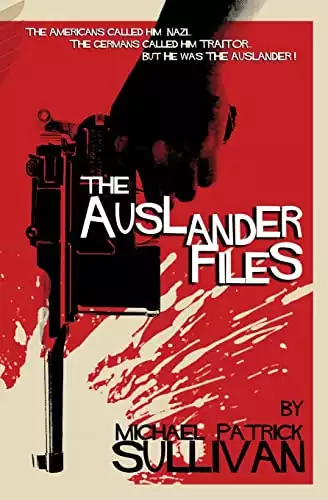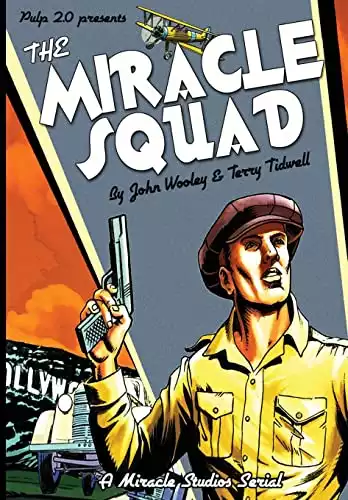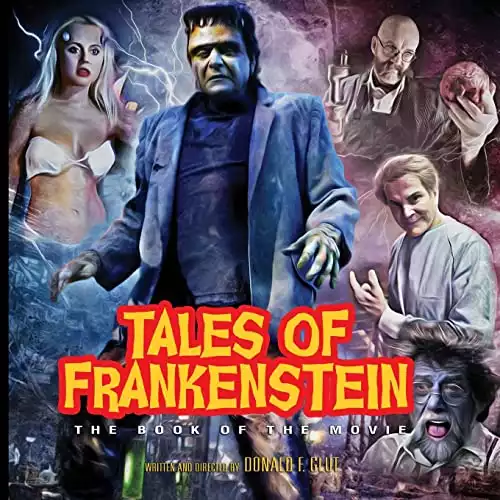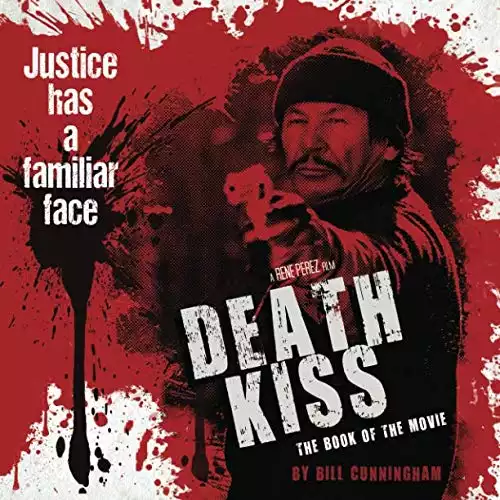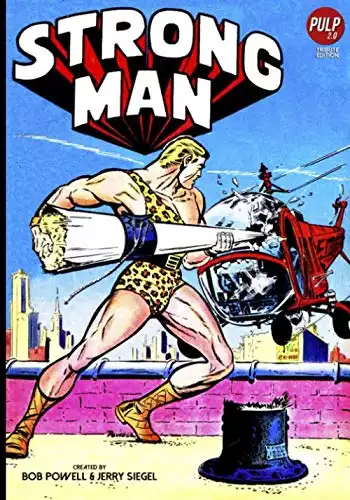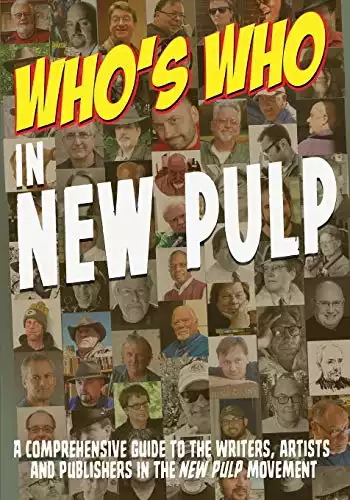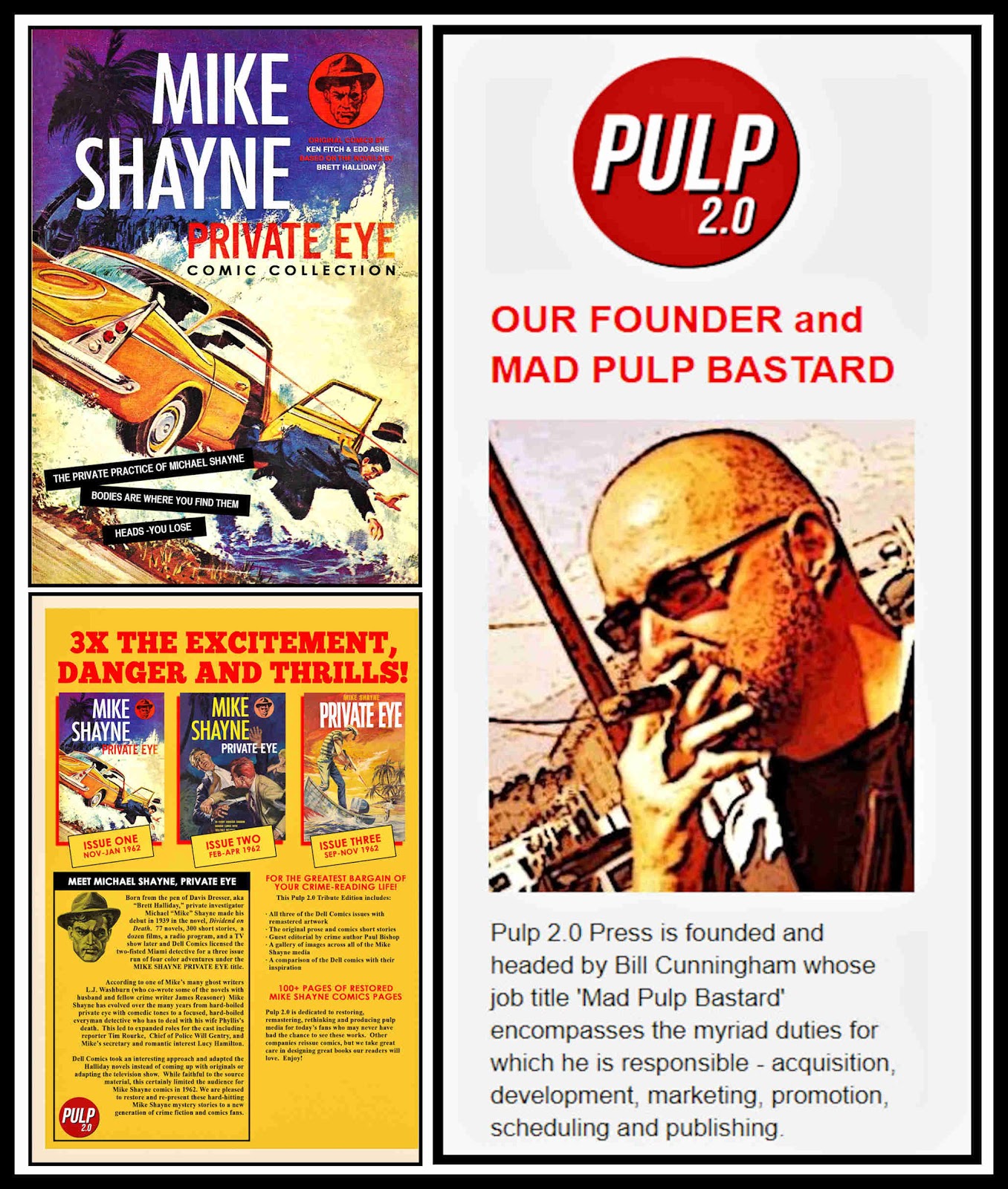
Lately, I’ve been on a Mike Shayne kick.
My reading and watching involving that famed Miami-based Private investigator has led to a series of posts on this blog, starting one about the first appearance of a Mike Shayne story in a men’s adventure magazine, “The Naked Frame” in BLUEBOOK, February 1953.
I blame my Shayne trip on my new friend Bill “Mad Pulp Bastard” Cunnigham and my old friend, novelist, editor and retromedia maven Paul Bishop.
Bill is the founder and creative force behind Pulp 2.0 Press, an imprint he initially launched to reprint classic pulp and paperback series he liked but were no longer in print. He has since turned Pulp 2.0 into a significant and ambitious publisher of a variety of old and new pulp-flavored books and media.
One of the latest Pulp 2.0 releases Bill ushered into existence is the MIKE SHAYNE: PRIVATE EYE, COMIC COLLECTION.
It reprints a series of rare, long-forgotten Mike Shayne comic books published by Dell in 1962. The introduction to that collection is an excellent overview of the Shayne character, who was created by author Davis Dresser.
Dresser wrote his first novel about the tough, red-headed PI in 1939, under the pseudonym Brett Halliday.
It launched what became a multi-decade multimedia empire that went on to include: over 70 novels and 300 stories written by Dresser and other writers using the Brett Halliday pen name; a dozen movies; a television series; a radio series; a short-lived comic book; and, the long-running MIKE SHAYNE MYSTERY MAGAZINE.
The latter provided a crucial early outlet for crime and mystery stories written by dozens of writers – including Paul Bishop. I didn’t know Paul wrote the introduction to the MIKE SHAYNE: PRIVATE EYE, COMIC COLLECTION until I bought the book, but I wasn’t surprised. Paul is a mover and shaker in the pulp culture community who I’ve known and been a fan of for some years.
I’ve done several posts about him on this blog, most recently about his contributions to HOT LEAD, the great new Westerns fanzine published by Justin Marriott.
Among other things, Paul is a veteran LA police detective, a popular crime and mystery novelist, editor of the boxing-related FIGHTCARD novel series and the PATTERN OF BEHAVIOR crime story anthology series. A few years ago, he graciously wrote an afterword for our book BARBARIANS ON BIKES: BIKERS AND MOTORCYCLE GANGS IN MEN’S PULP ADVENTURE MAGAZINES.
Lately, Paul has been co-hosting the very cool Six-Gun Justice Podcast, an outgrowth of his work as an editor for Wolfpack Publishing and his in-depth knowledge of Western novels, movies, and TV shows (also reflected in his 52 WEEKS * 52 WESTERNS book series).
 I don’t know how Paul became a go-to expert on so many different genres, but he’s also has an encyclopedic knowledge of detective novels, movies, and TV shows. So, it made perfect sense for Bill Cunningham to tap Paul for the introduction to the MIKE SHAYNE: PRIVATE EYE, COMIC COLLECTION.
I don’t know how Paul became a go-to expert on so many different genres, but he’s also has an encyclopedic knowledge of detective novels, movies, and TV shows. So, it made perfect sense for Bill Cunningham to tap Paul for the introduction to the MIKE SHAYNE: PRIVATE EYE, COMIC COLLECTION.
Reading Paul’s introduction gave me a whole new appreciation for the popularity and evolution of the Shayne character and how the comics fit into that legacy. It made reading the comic book stories, which are beautifully restored in full color in Bill’s book, even more interesting.
Paul’s intro and the book also made me realize I needed to read more Mike Shayne novels, check out the Shayne movies, TV shows and radio series, and look into appearances of Mike Shayne stories in men’s adventure magazines.
That book also made me want find to out more about Bill Cunningham and what he’s up to with Pulp 2.0 Press.
When I browsed the Pulp 2.0 website, I was amazed by the unique and cool things Bill is putting out: everything from the first English versions of the hard-boiled Chilean comic book series KILLER, by artist Germàn Gabler, and reprints of old pulp stories about the character AGENT 13, to movie-related books, a new fanzine, LETHAL LADIES, which focuses on “fantastic femmes of pop culture – paperbacks, comics, movies, TV, and elsewhere,” and more.
I contacted Bill and asked if he’d do an interview with me for this blog. He said “yes.” The resulting conversation is below…
BOB: Let’s start with some background on you. I see from your bio on the Pulp 2-0 website and in Airship 27’s new book WHO’S WHO IN NEW PULP that you have previously been a screenwriter, movie producer, and author. How did that experience lead to your creation of Pulp 2.0 and your vision for it?
BILL: Yes, I am one of the many people who have migrated to California to work in the movie business. I guess it all goes back to when I was in the US Air Force from 1986 to 1990. I was stationed at Nellis Air Force Base in Las Vegas, Nevada but spent most of my time on the test range up in Tonapah working with the F117A Stealth Fighter. We would come home to Vegas for the weekend and many of us would hop in the car and head down to Los Angeles to get away from the Vegas tourist traps.
After my tour in the Air Force, I decided I wanted to try something new so I went back to school in South Carolina and earned a second degree in what they called “media arts,” which is studies in film, video, audio, and photography. I worked on many commercials, independent films, industrials, and movies that came to South Carolina to shoot because it was cheap, like DIE HARD: WITH A VENGEANCE. After doing that for several years, I realized I needed to move to SoCal to really “get into the business.” I was writing scripts by that time, and it seemed the right thing to do.
I went to work as an assistant for exploitation director-producer Nico Mastorakis, known for movies like ISLAND OF DEATH and THE ZERO BOYS, and eventually became a producer on one of his movies. I then became the Director of Marketing for York Entertainment and became proficient at making and marketing movies on a low budget. The good thing about indie companies like Nico’s Omega Entertainment and York is they let you get your hands dirty.



Eventually, I worked my way out of that job as well and was able to support myself by applying “Hollywood techniques” to videos and other media for clients in other industries. The pay was better — until 2008 when the bottom dropped out and I lost half of my clients to the housing collapse. I needed money, and I decided that since no one was financing indie movies or other media I needed to come up with something that I owned, and projects I could greenlight myself without any money. I chose book publishing and thought if I could apply all the things I’ve learned in moviemaking and selling to books, I would do okay.
How did you pick the name Pulp 2.0 and how do you define “pulp”? As you know, the use of the term “pulp” is somewhat controversial to afficionados of early pulp magazines, who think it should only be used to describe classic pulp magazines – a view I don’t share, by the way, as you can tell from my use of the term “men’s pulp mags” as an alternate name for men’s adventure magazines.
The term “Pulp 2.0” came about when I realized that the internet was the next (digital) iteration of the pulp model of business. That is, you had to make it fast, cheap, and distribute it as quickly and cheaply as possible. There was a constant need for entertainment, and it needed to be able to be accessed from anywhere. So that’s what I do – use the tools of the web to create new media and sell it directly to the consumer. As little overhead as possible, and limited distribution and operation costs. I’m applying those laws to books right now, but if you look at Netflix, Amazon Prime, Tubi, and Pluto, etc… you can see the Pulp 2.0 model applies to movies as well.
Can you give me and my readers an overview of the Pulp 2.0’s publications to date?
BILL: Sure. When I started, I didn’t know what I was doing so I just aimed as high as I possibly thought I could go. I licensed THE NEW ADVENTURES OF FRANKENSTEIN series from author Donald F. Glut. He wrote 11 novels in the series, and if I were to buy used copies on eBay it would have cost me around $300. I thought we could do better and reintroduce the Frankenstein monster to creature feature fans. I also licensed Don’s vampire novel BROTHER BLOOD which was written before BLACULA but wasn’t released here in the States. Before I knew it we were releasing Martin Powell’s Frankenstein graphic novel adaptation with Patrick Olliffe, the KNIGHT WATCHMAN and other BIG BANG COMICS by creators Chris Ecker, Gary Carlson, and Jeff Weigel, the complete AGENT 13 TRILOGY by Flint Dille, writer of TRANSFORMERS GEN ONE, and David Marconi, writer of the Will Smith movie ENEMY OF THE STATE.



Then I published THE AUSLAUNDER FILES, by Michael Patrick Sullivan, THE TWILIGHT AVENGER and MIRACLE SQUAD books by John Wooley and Terry Tidwell, and many others. Last year we released our first original graphic novel, TALES OF FRANKENSTEIN, based on Don Glut’s new, Rondo-award-winning movie of the same name. We were very excited to get a foreword by none other than Jim Steranko for that one.
Each one of these book projects was born from the notion that I want to see that book on my shelf. I didn’t have to go to some executive and beg for money, or get the go-ahead from my boss. We sat down, talked it out, signed an agreement, and then made something.

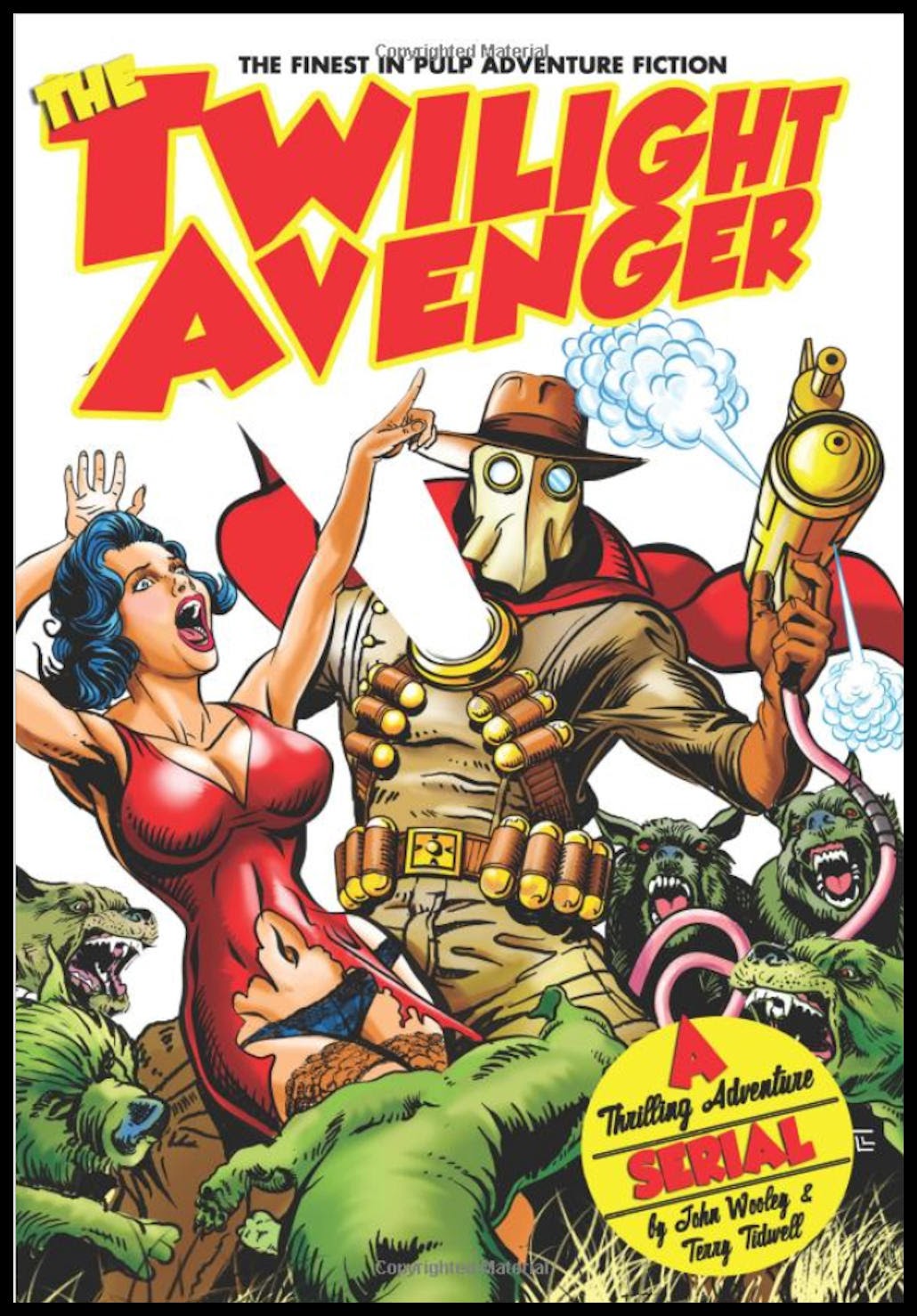
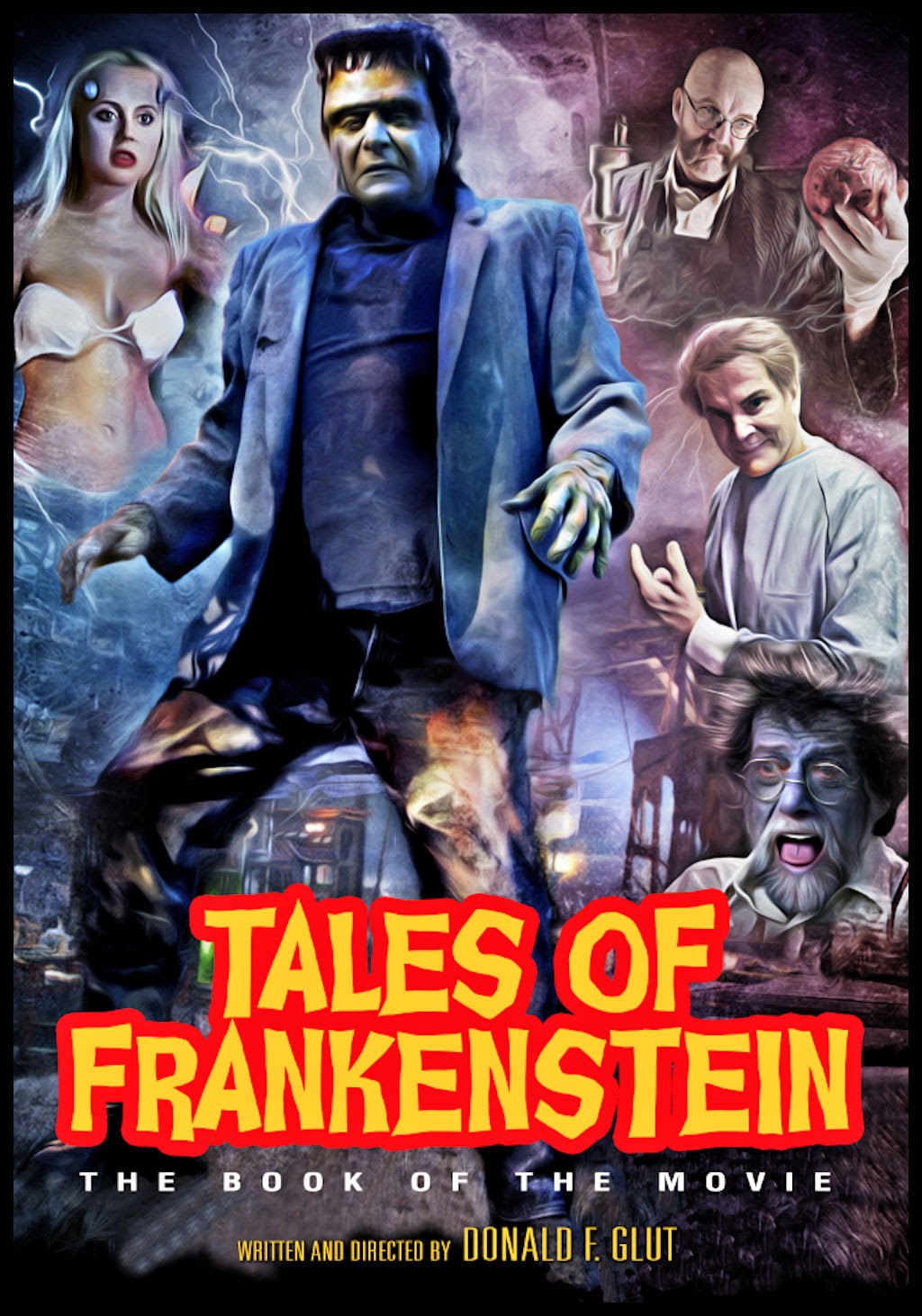
From those small beginnings, we’ve expanded and I’ve licensed the KILLER spy comics from Chile’s Germán Gabler, and published two volumes of those. I also licensed TERROR COMICS from Spain’s Joan Boix. I took his character The Raven and made THE RAVEN COLLECTION, a volume collecting all of his comics stories. Usually, it just takes a good conversation to find out what the creator would like to see.
I also launched a film book series, CINEXPLOITS!, and have released movie books on TALES OF FRANKENSTEIN and DEATH KISS, both of which I also wrote. There’s also the upcoming CELLULOID WARS: LESSONS LEARNED FROM BATTLE BEYOND THE STARS.
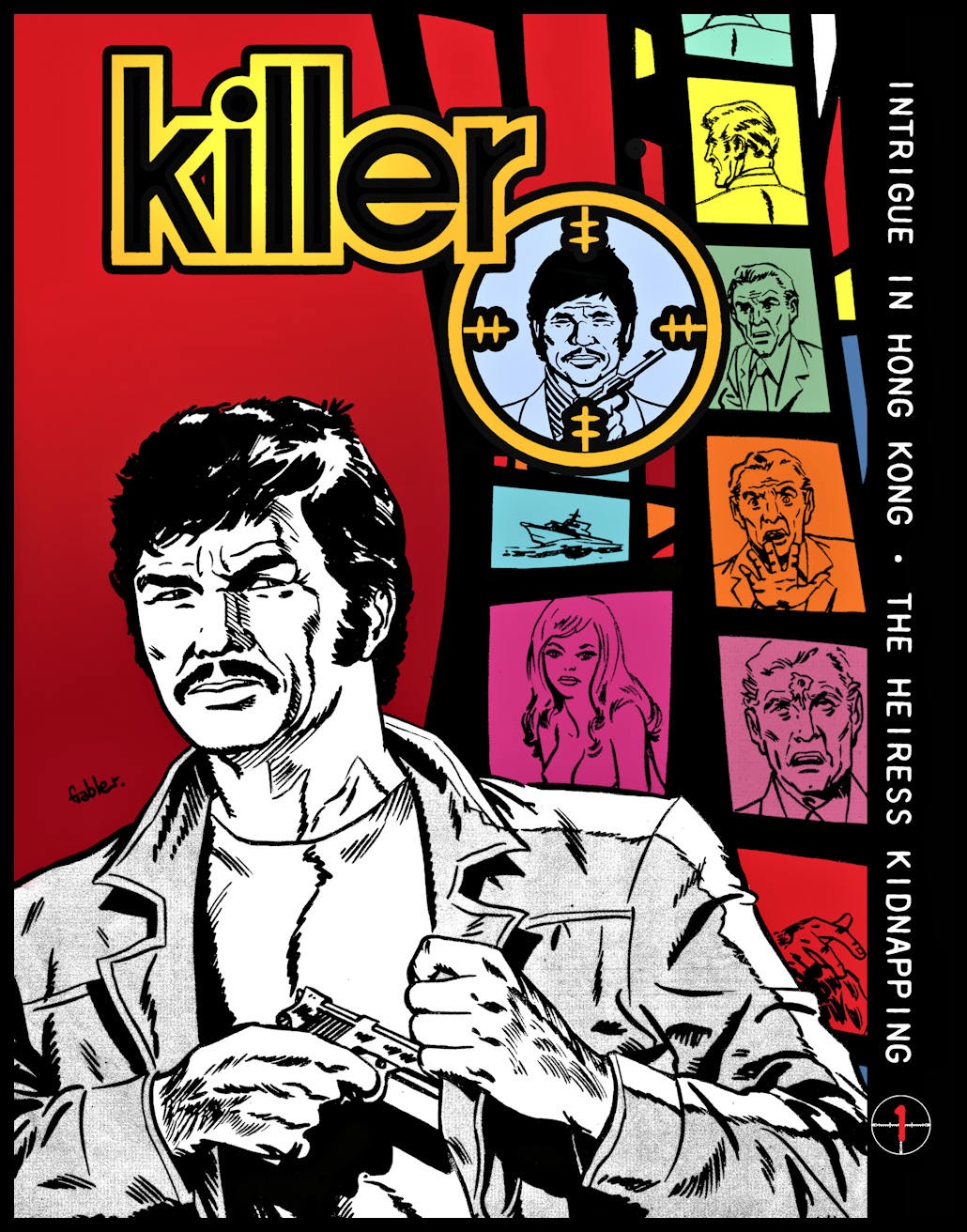
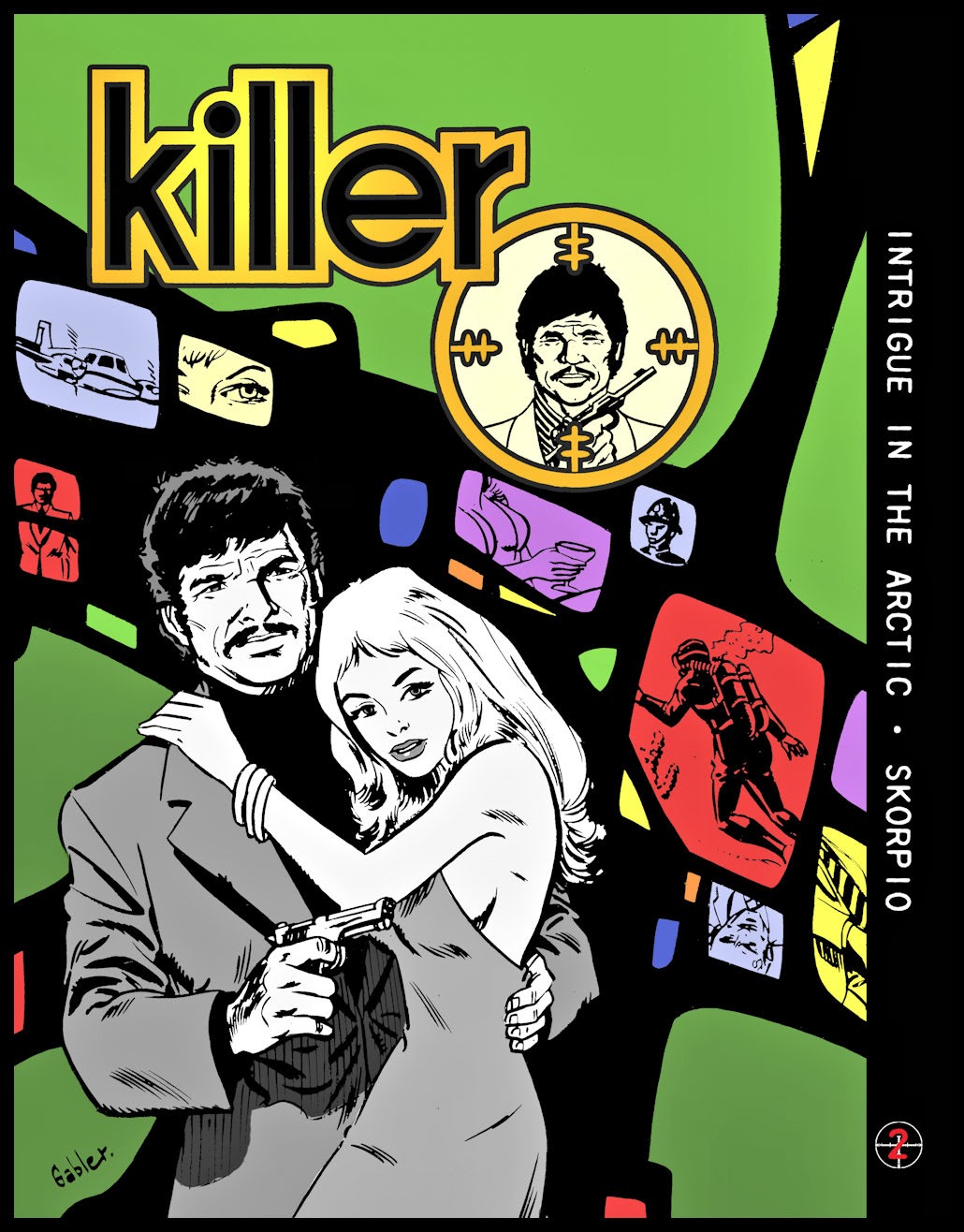
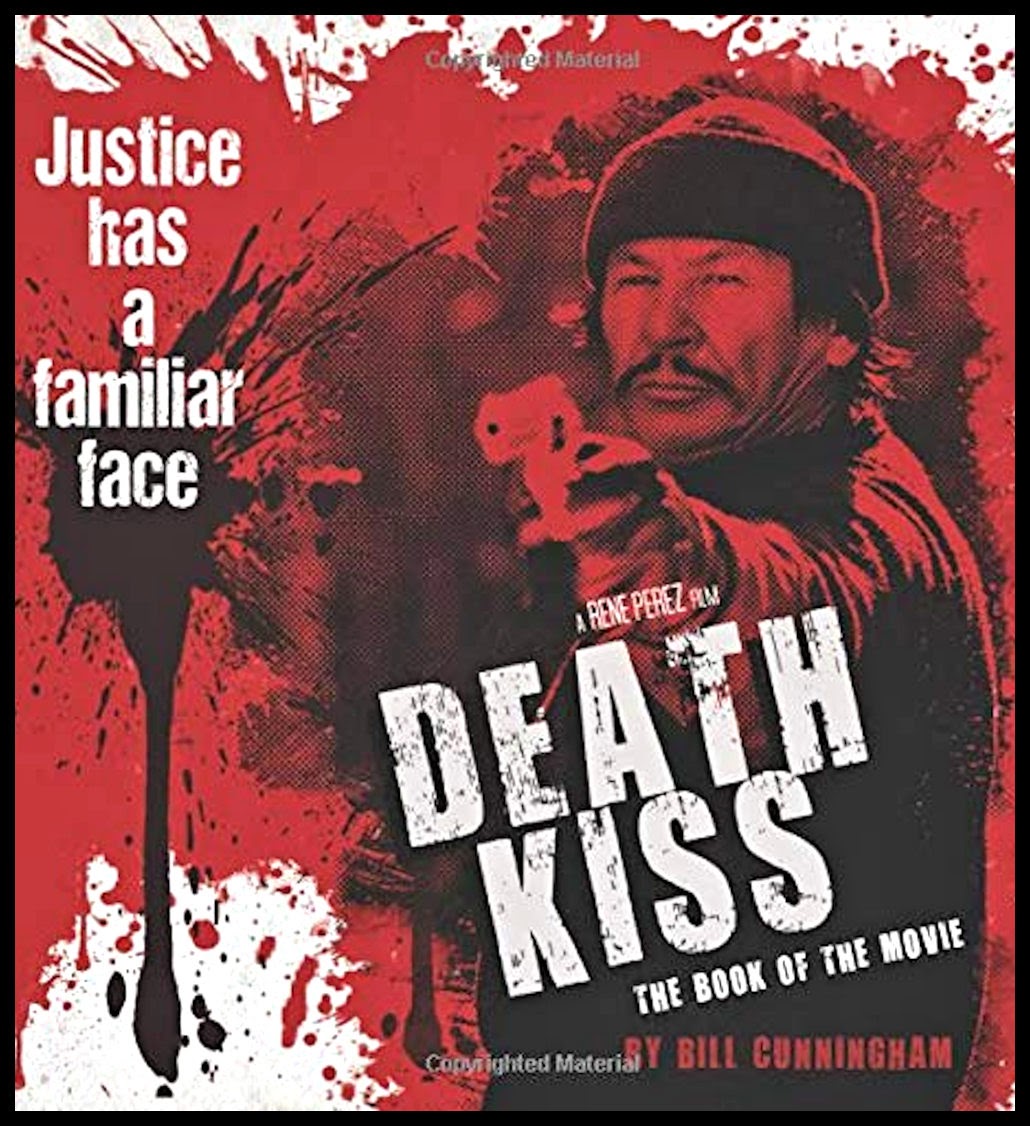
The MIKE SHAYNE anthology is your latest release. How did you get inspired to do a reprint of that old comics series?
BILL: I had recently “reclaimed” a comic series, STRONGMAN, from Magazine Enterprises, and put together a tribute book for this muscle-man detective-adventurer in the space of 72 hours. I did the Mike Shayne book, more as a lark than anything else. I had seen another company’s reprint of the book, and it was if they put no effort into it at all. I want people to see the effort I put into making sure you have a well-designed book that doesn’t cost you an arm and a leg to buy.
You definitely did that. Your Mike Shayne book is beautifully designed. In fact, the layouts and printing quality of your books look top-notch. Where’d you learn the art of doing layouts and how do you approach the layouts of different types of projects?
 BILL: Thank you for your kind words, and I’m glad you’re seeing the work I and my fellow creators put into the books. Each project is different and requires a focus on what I’m trying to deliver to the Pulp 2.0 audience. Most of all I’m trying to invoke a feeling of authenticity. You take a look at one of our books and you might mistake it for something from back in the 70’s or further, or you know that the people who put the book together love the material, which I do. For example, for our recent TALES OF FRANKENSTEIN graphic anthology, I took design cues from Warren and Skywald horror magazines.
BILL: Thank you for your kind words, and I’m glad you’re seeing the work I and my fellow creators put into the books. Each project is different and requires a focus on what I’m trying to deliver to the Pulp 2.0 audience. Most of all I’m trying to invoke a feeling of authenticity. You take a look at one of our books and you might mistake it for something from back in the 70’s or further, or you know that the people who put the book together love the material, which I do. For example, for our recent TALES OF FRANKENSTEIN graphic anthology, I took design cues from Warren and Skywald horror magazines.
I learned book publishing and layout from working with graphic designers my whole career. When I was the Director of Marketing at York I would ask for a certain something — an effect, a color change, an angle shift — and watch them do it. Eventually, I began doing it myself. Then I designed a client’s poster from the ground up, then a catalog, then a website, then I began learning how to do it with books.
The first comic book I lettered was TALES OF FRANKENSTEIN, and I learned how by watching YouTube videos and applying my sense of design to the project. It’s all about making choices and sticking with them. You start simply and then slowly begin to experiment. If you screw up, you call out for help.
I love working with older, scanned materials and repurposing them. It’s all part of my “reclaiming pulp culture” philosophy.
I see on your website announcements of plans for some very cool-looking new projects. Can you tell us more about them?
BILL: I am finishing the KILLER series and releasing that as a five-volume set. Our Cinexploits! book CELLULOID WARS: BATTLE BEYOND THE STARS will have a companion volume by the director, Allan Holzman, called CELLULOID WARS: FORBIDDEN WORLDS.
I’m also working of finalizing the first issue LETHAL LADIES: THE JOURNAL OF BADASS ADVENTURE HEROINES, is a magazine I am editing and writing that does a deep dive into novels like the DARK ANGEL series and its creators.
 Other volumes of that will include explorations into female-led action heroines from comics, books, movies, and TV. Comix is a three-volume exploration of the world of comic book movies and TV prior to today’s mega-blockbusters. Terror Comics is Joan Boix’s wonderfully Hammer-esque, graphically penetrating horror comics from Spain.
Other volumes of that will include explorations into female-led action heroines from comics, books, movies, and TV. Comix is a three-volume exploration of the world of comic book movies and TV prior to today’s mega-blockbusters. Terror Comics is Joan Boix’s wonderfully Hammer-esque, graphically penetrating horror comics from Spain.
There’s a bunch of other book projects I am exploring for both fiction and non-fiction. What can I say? I like to stay busy.
As an indie publisher myself, though on a smaller scale than you, I’m also curious about how you do your printing and distribution of your books and your take of the pros and cons of print books and ebooks?
BILL: Over the years I have learned that it’s always best to focus on your audience: What do they want? How do they want it? It’s important to know them, and then just try to feed that beast with as much “meat” as you can. My focus is always on the stuff I’m good at – book design, packaging, merchandising – and leave the other stuff up to my partners like Amazon. They can handle the operations and fulfillment better than I ever could.
I am only now getting back into ebooks after a long hiatus. I started out doing ebook editions and everyone kept asking me when I was coming out with the print books! Then I switched to focusing more on print and people then asked when they would see the ebooks. I decided to focus on what paid us the most money as quickly as possible. Don’t listen to the loudest voice, listen to the voice that is also waiving its money at you begging you to take it. I take the ebook route to use them as advertising and promotion for the more profitable print books.
I use both ebooks and print freely in my regular reading habits. I go back and forth quite often depending on what I want to read. Ebooks for me are a convenient tool for reading, and print books are “affordable fetish objects” that sit on my shelf.
Nowadays, there are thousands of reprints of books of every kind available on Amazon for 99 cents or even for free and bookstores are scarce. So independent publishing is not some easy, get rich quick scheme. However, there seems to be a growing number of independent publishers who are putting out new reprint editions of old novels and as well as new books in the action/adventure, retro pulp, and “new pulp” realms, and fanzines that focus those genres. Why do you think there’s a surge in that realm of indie publishing?
BILL: Amazon and other resources have made it possible for us to dream something and then make it. You don’t have to go into hock to get a book printed and shipped. You can write, design, and deliver a book without ever spending a dime – that is incredibly liberating!
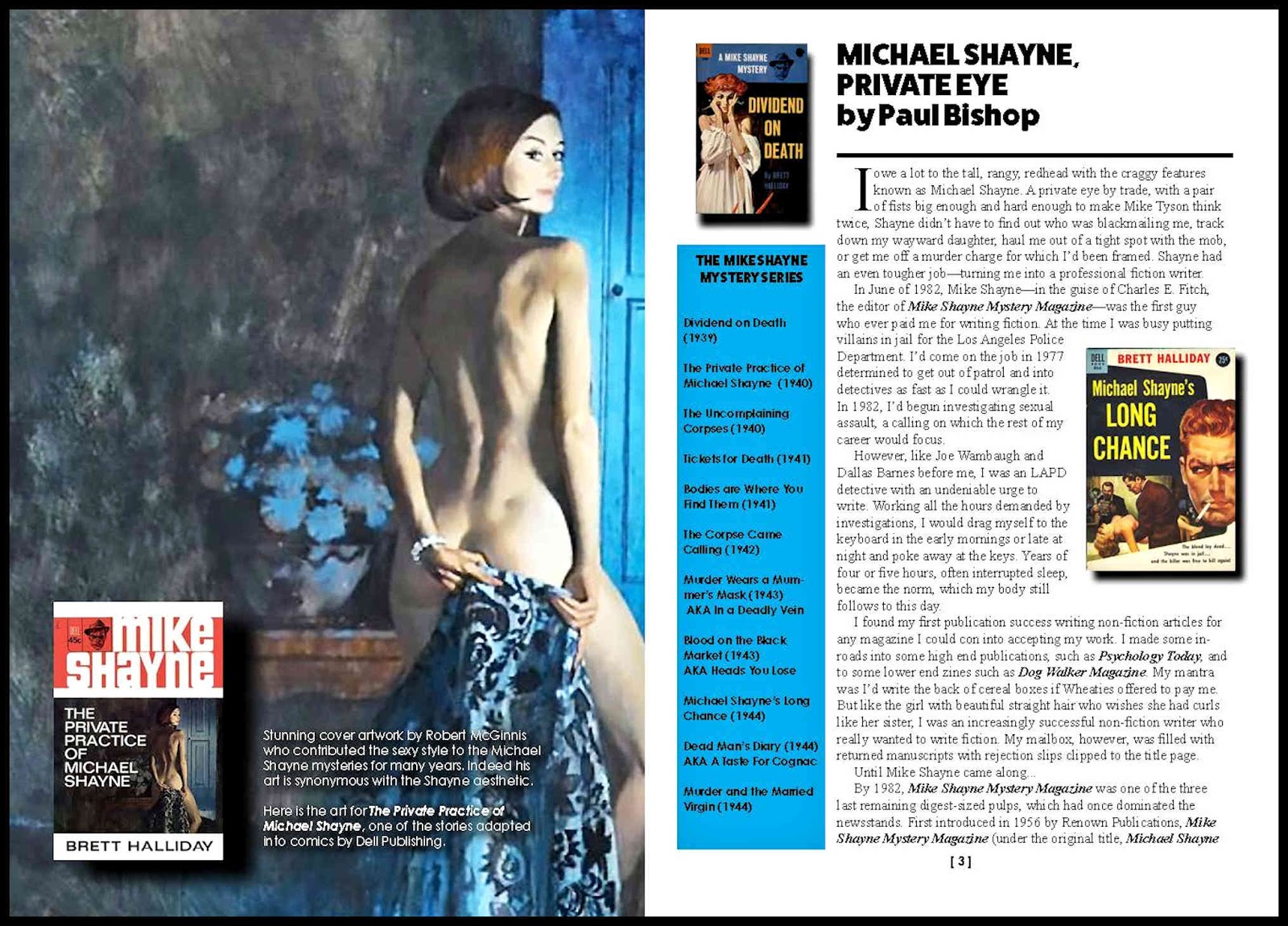 The downside, of course, is that you get a bunch of books that are poorly written, poorly designed, and poorly printed. You need to have some talent (authenticity?) backing up your work. As you said, this is not a get rich quick scheme. You need a series of base hits to work your way around the bases. Sometimes you’re going to strikeout. Keep working. Adopt, adapt, re-think.
The downside, of course, is that you get a bunch of books that are poorly written, poorly designed, and poorly printed. You need to have some talent (authenticity?) backing up your work. As you said, this is not a get rich quick scheme. You need a series of base hits to work your way around the bases. Sometimes you’re going to strikeout. Keep working. Adopt, adapt, re-think.
I was interested to find that your MIKE SHAYNE book has a cool introduction by my friend Paul Bishop, one of my favorite pulp mavens. And, you’re also working with another one of my favorite pulp mavens, fanzine publisher Justin Marriott. Tell us something about how you hooked up with those guys and what you’ve been cooking up with them.
BILL: I’ve known Paul for years as we connected online as writers. He introduced me to the zines Justin was putting out from the UK – though I didn’t pick them up back then. I loved his approach and became a fan. When he switched to using Amazon as his printer and distributor, I bought some of the issues he made available and my fanaticism was cemented. I wrote to Paul and told him to tell Justin that I was a fan of his work and if he wanted some more cover designs I could provide them. I included a quick design I put together as a calling card.
About a year later, Justin contacted me to see if I was interested. The rest is history. I contributed a cover to his MEN OF VIOLENCE ALL-REVIEW SPECIAL, then to his PULP HORROR zine, then his HOT LEAD ALL REVIEW SPECIAL and the debut issue of MONSTER MANIACS. I just finished working on his new zine about post-apocalyptic novels and comics, PULP APOCALYPSE and I’m trying to convince Justin we need to deliver a “Space Adventure” zine.
The great thing about Justin is he’s insightful, and every comment he makes allows me to focus the design on everything needed to appeal to the reader. I try to get the first draft to him early so we can start the process and develop ideas we can do well. He’s also open to me experimenting. Our Pulp Horror tribute cover is a good example. That image from Stir of Echoes was so powerful I didn’t want to screw with it, so we let it be the hero. Justin is really brave that way. Someone else would have wanted me to muck it up with all sorts of design tomfoolery.
What are the next publications coming from Pulp 2.0 in 2020 and 2021?
BILL: I am wrapping up Killer for this year. Allan Holzman and I are enticing a certain “filmmaking celebrity” to write the foreword for Celluloid Wars: BBTS, and translation continues on Joan Boix’s Terror Comics. You’ll also be seeing more short fiction from me for Kindle. I have all of these notes and ideas scribbled in my notebooks that I must put to good use. Research continues on Comix and Lethal Ladies and I can always be convinced to jump into and add to a cool project here and there.
Thanks, Bill! I look forward to those — and to catching up on previous Pulp 2.0. books I haven’t read yet.
Comments? Corrections? You can email them to me, or
join the Men’s Adventure Magazines & Books Facebook Group and post them there.
Related reading…









